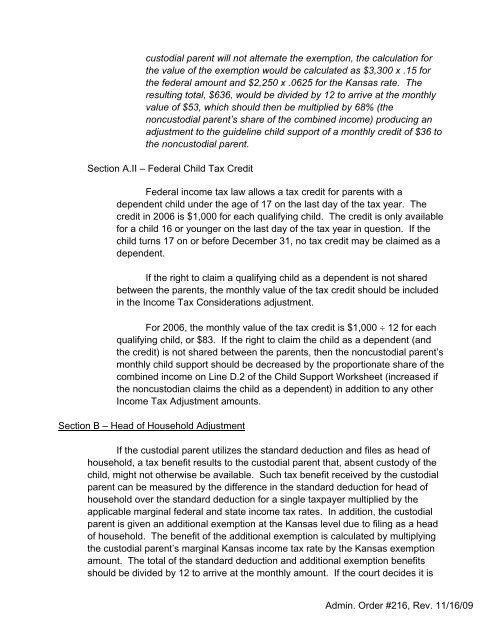APPENDIX V Income Tax Considerations Section A
APPENDIX V Income Tax Considerations Section A
APPENDIX V Income Tax Considerations Section A
You also want an ePaper? Increase the reach of your titles
YUMPU automatically turns print PDFs into web optimized ePapers that Google loves.
custodial parent will not alternate the exemption, the calculation for<br />
the value of the exemption would be calculated as $3,300 x .15 for<br />
the federal amount and $2,250 x .0625 for the Kansas rate. The<br />
resulting total, $636, would be divided by 12 to arrive at the monthly<br />
value of $53, which should then be multiplied by 68% (the<br />
noncustodial parent’s share of the combined income) producing an<br />
adjustment to the guideline child support of a monthly credit of $36 to<br />
the noncustodial parent.<br />
<strong>Section</strong> A.II – Federal Child <strong>Tax</strong> Credit<br />
Federal income tax law allows a tax credit for parents with a<br />
dependent child under the age of 17 on the last day of the tax year. The<br />
credit in 2006 is $1,000 for each qualifying child. The credit is only available<br />
for a child 16 or younger on the last day of the tax year in question. If the<br />
child turns 17 on or before December 31, no tax credit may be claimed as a<br />
dependent.<br />
If the right to claim a qualifying child as a dependent is not shared<br />
between the parents, the monthly value of the tax credit should be included<br />
in the <strong>Income</strong> <strong>Tax</strong> <strong>Considerations</strong> adjustment.<br />
For 2006, the monthly value of the tax credit is $1,000 ÷ 12 for each<br />
qualifying child, or $83. If the right to claim the child as a dependent (and<br />
the credit) is not shared between the parents, then the noncustodial parent’s<br />
monthly child support should be decreased by the proportionate share of the<br />
combined income on Line D.2 of the Child Support Worksheet (increased if<br />
the noncustodian claims the child as a dependent) in addition to any other<br />
<strong>Income</strong> <strong>Tax</strong> Adjustment amounts.<br />
<strong>Section</strong> B – Head of Household Adjustment<br />
If the custodial parent utilizes the standard deduction and files as head of<br />
household, a tax benefit results to the custodial parent that, absent custody of the<br />
child, might not otherwise be available. Such tax benefit received by the custodial<br />
parent can be measured by the difference in the standard deduction for head of<br />
household over the standard deduction for a single taxpayer multiplied by the<br />
applicable marginal federal and state income tax rates. In addition, the custodial<br />
parent is given an additional exemption at the Kansas level due to filing as a head<br />
of household. The benefit of the additional exemption is calculated by multiplying<br />
the custodial parent’s marginal Kansas income tax rate by the Kansas exemption<br />
amount. The total of the standard deduction and additional exemption benefits<br />
should be divided by 12 to arrive at the monthly amount. If the court decides it is<br />
Admin. Order #216, Rev. 11/16/09
















